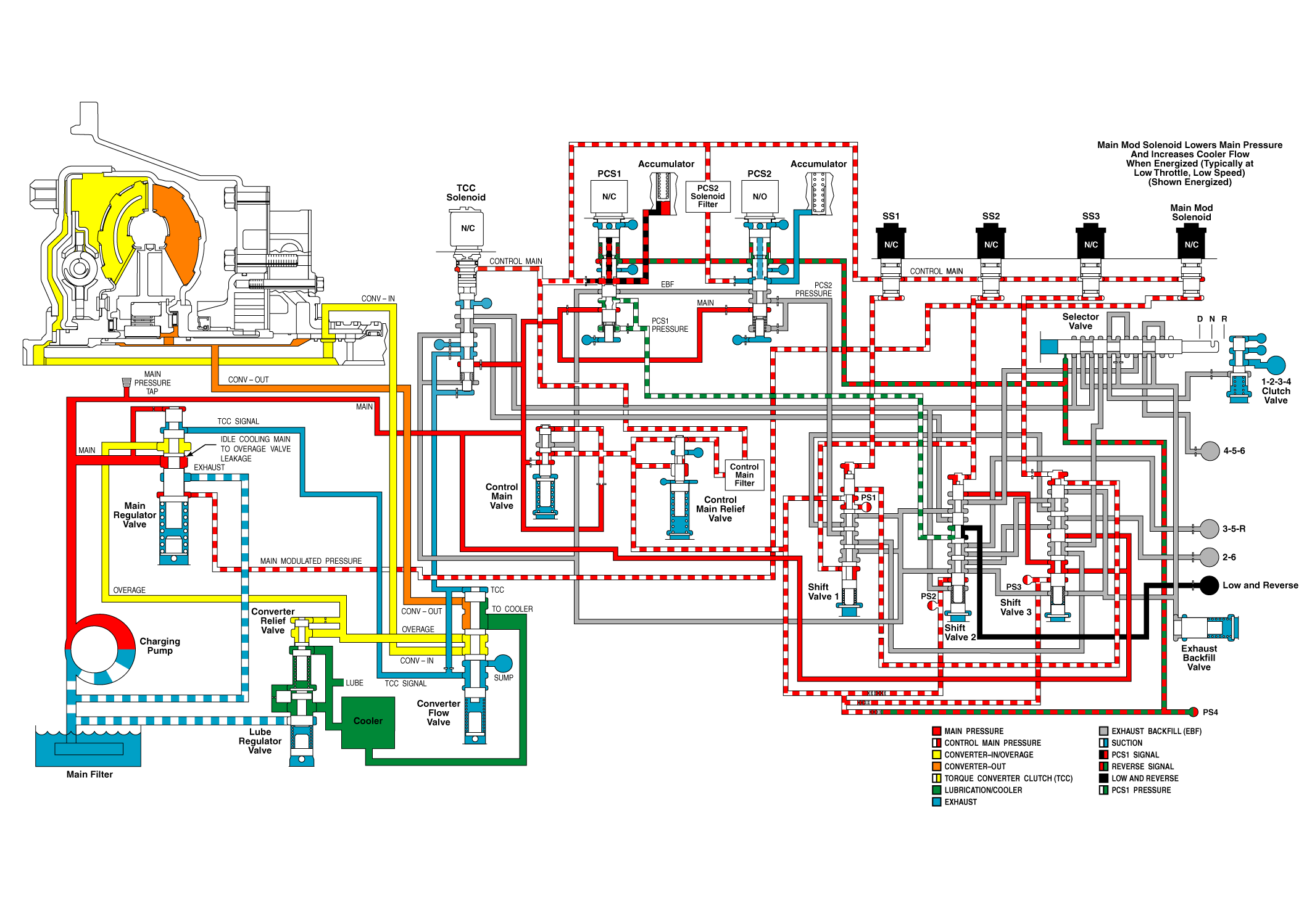In Neutral (N), pressure control solenoid 1 (PCS1) is in the normally closed state (de-energized), PCS2 is in the normally open state (de-energized), shift solenoid 1 (SS1), SS2, and SS3 are energized, and the torque converter clutch pressure control solenoid (TCC PCS) remains de-energized.
SS1, SS2, and SS3 supply control main pressure to the top of shift valve 1, shift valve 2, and shift valve 3, stroking the valves against spring force.
With shift valve 1 stroked, control main pressure is directed through shift valve 1 to pressure switch 1, turning the switch on. With shift valve 2 stroked, the exhaust path is blocked for the control main pressure being supplied through an orifice to pressure switch 2, and the pressure raises to control main and pressure switch 2 turns on. With shift valve 3 stroked, the exhaust path is blocked for the control main pressure being supplied through an orifice to pressure switch 3, and the pressure raises to control main and pressure switch 3 turns ON. With pressure switch 1, pressure switch 2, and pressure switch 3 ON, feedback is provided to the transmission control module (TCM) that shift valve 1, shift valve 2, and shift valve 3 are stroked.
Normally closed PCS1 blocks the exhaust of the PCS1 signal pressure, raising the signal pressure. PCS1 signal pressure strokes pressure control valve 1, raising the PCS1 pressure which is directed to shift valve 2. In the stroked position, shift valve 2 routes fluid to the low and reverse clutch, applying the clutch. All other clutches are exhausted.
With only one clutch applied, the transmission is in Neutral (N).
If electrical power is interrupted while Neutral (N) is selected, SS1, SS2, and SS3 are de-energized and shift valve 1 de-strokes. Due to valve timing, when power is lost, shift valve 1 strokes faster than shift valve 3. When shift valve 1 de-strokes, control main pressure is fed through shift valve 1 to the top of shift valve 3, keeping the valve stroked. Normally closed PCS1 continues to block the exhaust of the solenoid signal pressure (solenoid signal remains control main). The solenoid signal pressure on top of pressure control valve 1 produces maximum pressure, which is routed to shift valve 2. Shift valve 2 stays stroked due to the "latching" effect of the low and reverse clutch pressure acting on two different diameter lands. In the stroked position, pressure continues to be routed to the low and reverse clutch, keeping the clutch applied. Since only one clutch is applied, the transmission remains in Neutral (N).
If electrical power is interrupted with the transmission in Neutral (N) and the manual selector valve is moved to a forward range or reverse, the transmission stays in neutral because shift valve 3 stays de-stroked and main pressure is blocked from reaching the manual selector valve.
If the engine is shutdown and restarted with the electrical power interrupted to the TCM, shift valve 1, shift valve 2, and shift valve 3 remain de-stroked. Normally closed PCS1 blocks the exhaust of the PCS1 signal pressure (signal pressure becomes control main). The solenoid signal pressure on top of PCV1 produces maximum pressure, which is routed to shift valve 2. In the de-stroked position, shift valve 2 routes fluid to the 3rd, 5th, and reverse clutch. All other clutches are exhausted, so the transmission remains in Neutral (N). When shift valve 3 is de-stroked, main pressure is routed through shift valve 3 to the manual selector valve. If a forward range is selected, the manual selector valve routes fluid to the 1-2-3-4 clutch. 3rd, 5th, and reverse clutch remains on with the 1-2-3-4 clutch, resulting in third range being attained for limp home capability. If Reverse (R) is selected, the selector valve directs fluid through the TCC valve and shift valve 2 to low and reverse clutch. 3rd, 5th, and reverse clutch remains on with low and reverse clutch, resulting in Reverse (R) range being attained.
Neutral

